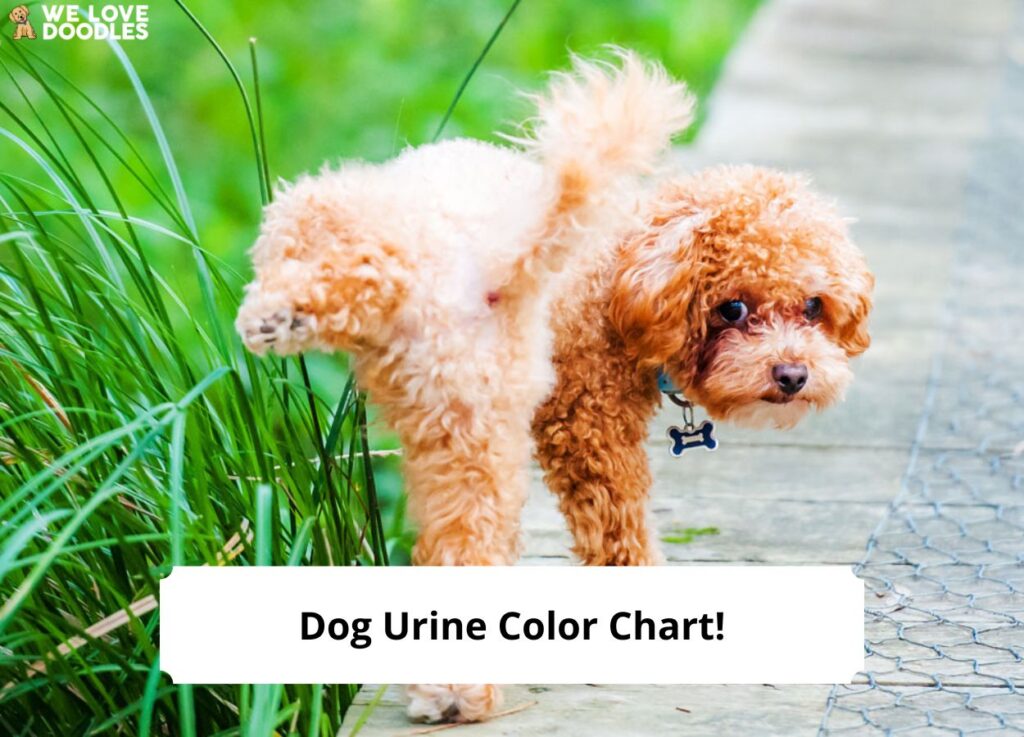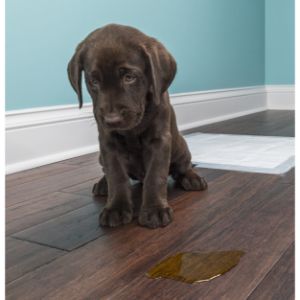
You should check your dog’s urine if he or she seems unwell and you are unable to identify the cause. Urine analysis is a crucial tool for determining a dog’s health. Your dog’s urine may change color, which could indicate some underlying health problems. We’ve created this dog urine color chart to help.
What potential colors may dog urine have? Simply put, a dog’s pee can be anywhere from transparent to black. Your dog’s level of hydration or an underlying medical issue can be determined by the color of its pee.
In this article, we’re going to discuss a variety of ailments connected to the urine color of your dog. Using the dog urine color chart below, you can determine whether your dog is experiencing any health issues.
Let’s examine the typical and unusual colors of dog urine.
Before you scroll down this guide, “Dog Urine Color Chart,” check out: Mucus in Dog Urine: What Does This Mean? (2023) and My Dog’s Urine Has a Strong Odor. What Does This Mean? (2023).
What Color is a Healthy Dog’s Urine?

The pee from your dog should be a light-yellow color. Now, it’s challenging to precisely characterize the shade of yellow because various individuals perceive colors in different ways. But we’ll try!
The color of a dog’s urine shouldn’t typically be translucent. In fact, it should be a clear yellow. As a result, a typical dog pees between a pale and light-yellow tint. In addition to color, a healthy dog should always have clean urine (without any floating particles). Any deviation from the norm is viewed as abnormal.
Is It Normal for a Dog’s Urine to be Yellow?

The urine of a healthy dog ought to always have a light-yellow tint. But if it begins to turn a darker shade of yellow or entirely changes color, it might be wise to consult a veterinarian.
What Does the Color of My Dog’s Pee Mean?

The color of your dog’s pee might reveal a lot about its health. Even though the color of your dog’s urine fluctuates throughout the day, it shouldn’t ever change to another color. Brown, green, or red urine is most commonly a sign of health issues.
Also, the color of your dog’s urine need not always be a sign of illness. Consider your dog’s pee as a “hydration meter” that displays its level of hydration. In other words, the color of your dog’s pee will vary based on how much water they consume.
The pee will be crystal clear the more water it consumes. Nonetheless, consuming too much of anything is bad for everyone, even your dog. Let’s examine what happens when your dog’s urine changes color.
The Color of Dog Pee: A Guide

Several medical issues can be connected to variations in a dog’s urine color. While some urine colors need immediate medical attention, others can be monitored by the dog’s owner.
In any event, you should be aware of the types of dog urine colors that signal a need for a vet appointment. Following a description of each color, we’ll discuss what it might indicate for your dog’s health.
Transparent Dog Urine Color
Dogs who have consumed too much water may produce pee that is transparent or clear. The opposite of dehydration, overhydration occurs when your dog consumes excessive amounts of water.
Fortunately, overhydration is less harmful than dehydration. Overhydration affects a dog’s body by diluting the consistency of the urine and blood.
Water can affect the stability and dispersion of electrolytes and other chemical components by thinning the blood’s consistency.
This may result in a chemical imbalance and blood pressure issues. Red blood cells can also get dehydrated. Higher blood volume may result from this, which can eventually cause renal issues.
Overhydration may seem harmless, but it can be fatal. At its most serious, overhydration can result in tissue edema, diarrhea, seizures, vomiting, and coma.
Bright Yellow and Light-Yellow Dog Urine Color

In dogs, a pale to light yellow urine color is typical. A dog that is this shade of yellow is properly hydrated — not too much or too little.
The colors of normal dog pee might differ based on nutrition, water intake, and exercise. It’s crucial to be aware that a dog typically changes the color of their poop throughout the day.
Also, it might shift if certain food items are present that tend to influence the color of urine. Beets, Brussels sprouts, asparagus, broccoli, carrots, and other such foods are examples.
Having said that, you should be careful about what you give your dog. Some human foods should be avoided because they can be quite hazardous to our beloved furballs.
Dark Yellow Dog Urine Color
Recall the hydration indicator. Dehydration is typically to blame when urine changes from its normal light-yellow tint to a dark-yellow color. This indicates that your dog probably hasn’t been getting sufficient water throughout the day.
You shouldn’t panic too much if you’ve noticed that your dog’s urine has gone dark yellow but then returned to normal the next time it urinated.
Dehydration can occur briefly. Yet, it might also represent a serious medical issue. Often, the only observable clinical symptom of a dangerous illness is dehydration. Hence, it’s recommended to have your dog examined if you observe that it’s dehydrated despite drinking water frequently.
Urine that is dark yellow occasionally has a pungent smell after it. The liver produces the chemical molecule urea, which is responsible for its odor. In the worst-case scenario, liver and renal disorders may be associated with dark yellow dog pee.
Orange Dog Urine Color

Urine’s orange hue can range from a rich orange to a dark yellow tone. So, what creates the orange coloration of dog urine? As much as we hate to admit it, dogs who have orange urine tend to have certain health issues.
Orange urine, in contrast to the other colors we’ve discussed, typically calls for a vet visit. Dogs with chronic liver illnesses, as well as those with pancreatic and gallbladder issues, frequently have orange urine. Dogs with orange urine are known to have jaundice, yet it can also indicate severe dehydration.
Red or Pink Dog Urine Color
The presence of red urine is cause for concern. Hematuria, which literally translates to “blood in urine,” is the medical term for red urine. What should you do if you see that your dog has blood-colored urine?
We strongly suggest that you take your dog to the veterinarian as soon as possible. The presence of red urine in your dog may be a clinical indicator of an acute urinary tract infection.
Babesiosis in dogs can also cause red urine to appear. This life-threatening medical ailment, known as “Red Water,” is caused by a tick bite. The seriousness of this potentially fatal medical condition cannot be overstated. For babesiosis, prompt veterinarian care is necessary.
Crimson or red urine in dogs may also be a symptom of long-term illnesses such as tumors, kidney disease, and liver disease.
Green Dog Urine Color

Chronic liver and gallbladder conditions, acute urinary tract infections, and other conditions might cause your dog’s urine to turn green. Hemolytic anemia is most likely the cause of green urine. This medical problem affects dogs pretty frequently. Red blood cells are destroyed in hemolytic anemia.
A greenish pigment is created during hemolysis, the breakdown of red blood cells, and it later gives your dog’s pee its color.
But a dog’s diet can cause green pee to develop. Green dog pee can occasionally be attributed to a diet high in plants. Therefore, your dog might urinate green when eating green foods like broccoli, Brussels sprouts, artichokes, and asparagus.
Nonetheless, the presence of green urine should prompt you to take your dog to the veterinarian because it may indicate a health issue.
Brown or Black Dog Urine Color
You need to take your dog to the vet right away if you see that it is urinating in either black or brown color.
Brown urine is a result of red blood cell destruction in dogs. Hemoglobin is a substance that red blood cells release when they are destroyed. Brown in hue, hemoglobin plays a crucial role in the blood’s ability to carry oxygen.
To put it another way, your dog’s urine turns brown or, in rare situations, black when there is blood in the urinary system.
Brown urine is frequently an indication of acute, significant diseases like poisoning, organ failure, severe dehydration, muscle injury, and urinary tract infections. The production of myoglobin, which can give your dog’s pee a dark red or dark brown hue, occurs with all types of muscle damage.
Brown urine in dogs may also indicate a prior chronic medical issue, such as kidney stones, persistent kidney infections, tumors, or gallbladder infections.
These illnesses harm the urinary system and result in bleeding. During an illness, the urinary system may hold onto blood and release it once the patient is healthy.
Dog’s Pee Viscosity

The color of a dog’s pee is not the only factor to consider when determining its health. The viscosity of a dog’s urine is a crucial sign of possible underlying, acute, or chronic medical issues.
It’s not necessary for a change in viscosity to be followed by a change in a dog’s pee color. Medical illnesses that interact with the body’s chemical composition can alter a dog’s pee’s viscosity.
So, it’s important to investigate if you detect anything unusual in your dog’s urine, such as odor, thickness, sliminess, or cloudiness.
Why Is My Dog’s Pee So Thick?

Dogs with thick urine may have a variety of conditions, and it’s not always indicative of a major illness.
Due to the mucous that surrounds the vagina, female dogs’ pee viscosity might change when they are in heat. This mucus combines with urine during urination to produce thick urine. During the mating process, sperm in male dogs may result in heavy urine.
Lipids are typically present in a dog’s urine, but they do not indicate any major health issues. These are typical fat globules found in dog pee. In addition, when the viscosity and color of urine both alter, this may be a sign of major medical illnesses such as renal failure, liver ailments, or even heart issues.
Sticky Urine in Dogs

Diabetes and sticky dog urine are related. And here is why.
Your dog’s urine contains too much sugar if they have diabetes. Glucose is the term for the sugar that the body produces.
“Glucose in a dog’s urine” is referred to as “glucosuria” in medical terminology. We also know that when sugar is liquid, it can become sticky. Your dog’s urine shouldn’t typically include glucose. The results of a urinalysis may reveal glucose, in which case your veterinarian may want to order some medical testing.
Cloudy Dog Pee

The presence of pus is typically indicated by cloudy dog urine. Pyuria is the name given to this condition. Chronic renal illness and acute urinary tract infections have been associated with cloudy dog pee.
Dehydration could also be indicated by cloudy, dark-yellow urine. Kidney crystals and stones are among the other medical disorders.
Mucus in a Dog’s Pee

As we previously said, a female dog’s heat cycle may be the cause of the mucous in her urine. You don’t have to be concerned about it.
Moreover, the presence of mucus in a dog’s pee can indicate an urgent gallbladder or urinary tract infection. It is vital to seek medical guidance even if mucus in your dog’s pee is not usually a serious warning sign.
Dog’s Pee Smells Funky

As there are no microorganisms, a dog’s pee is sterile. So why does your dog’s poop smell so terrible if it doesn’t contain any bacteria?
Dog urine generally has a moderate smell, and in some dogs, they almost have no smell at all. Hence, bacterial illnesses may be to blame if you discover that your dog’s pee smells awful or funky.
Your dog’s urine may smell like fish or rotten eggs due to urinary tract issues such as bacterial and viral illnesses. The odor has been referred to as “sour” by some dog owners. A change in urine color frequently occurs after this unpleasant odor.
Ammonia, a byproduct of the breakdown of urea molecules, is to blame for the odor. Thus, your dog’s pee smells unpleasant because of this breakdown product and germs found in the urine during a UTI illness.
It’s not really a good thing when dog urine is completely odorless. It’s only natural that a dog’s urine would have a slight smell to it. So, if your dog’s urine is odorless, it could be a sign of overhydration or impaired kidney function.
Colors of Dog Urine Throughout the Day

While walking your dog in the early morning, you may suddenly notice that its pee has a pale golden color. Often, when a dog’s urine color changes even a little, its owners begin to worry.
There is no reason to panic, despite the fact that it can be worrisome. A dog’s urine will typically change color throughout the course of the day. So, what shade should my dog’s morning pee be?
Your dog’s pee should be yellow soon after they get up in the morning. The color should stay yellow all day. But why does the color of yellow pee appear more vivid in the morning? Why is the morning scent of my dog’s urine so overpowering?
Due to less frequent water intake during the night, the color and smell of the urine have changed. Simply put, your dog will not really drink any water while it’s dozing off. At this point, the kidneys will make do with what they have.
Your dog’s kidneys are in charge of purifying the water he or she has consumed over the past day. The kidneys now extract the water from the produced urine when they have nothing else to work with. As a result, the urine’s concentration increases, affecting its overall color and scent.
The tint of the shade will gradually become paler to light yellow over the day. Your dog will often drink a lot of water throughout the day. Hence, drinking lots of water will make the urine less concentrated and its yellow hue lighter.
As a result, a dog’s pee changing slightly from yellow to another shade of yellow is entirely natural. Just remember, it should always be yellow. The brightness of yellow is the only thing that varies.
Frequently Asked Questions
If your dog has clear to yellow-colored urine, that is a sign of normal kidney function. If the urine is brown, red, or purple, there could be a serious kidney issue.
A dog with red or pink urine may have a urinary tract infection. If you notice this in your dog’s pee, you need to contact your veterinarian.
While the specific shade can vary depending on a few factors like diet and hydration, in general, yellow pee is a healthy color for dogs.
Conclusion for “Dog Urine Color Chart”

Hopefully, this dog urine color guide has assisted you in spotting any strange alterations in the color of your dog’s urine (if there are any). Our dogs can overcome health issues if we know what each color of their urine indicates.
Good dog owners are able to spot problems right away. But some dogs are adept at masking their discomfort. You might thus want to pay more attention to your dog’s posture in addition to the color of his or her pee.
Make sure to call your veterinarian if you discover that your dog’s pee matches one of the colors listed in this dog urine color guide. A quick urine test might reveal a lot!
Regular veterinary visits, quality food, and access to clean water will all greatly improve your dog’s general health.
If you find this guide, “Dog Urine Color Chart,” helpful, check out:
- Best Dog Shampoo for Urine Smell and Odor Control in 2023!
- Puppy Won’t Pee Before Bed: How to Train Them! (2023)
Learn more about a dog’s urinary problems by watching “5 Signs that your Dog has a Urinary Problem | How to Spot Urinary Problems in your Dog?” down below:
Garrett loves animals and is a huge advocate for all Doodle dog breeds. He owns his own Goldendoodle named Kona. In addition, he volunteers at the Humane Society of Silicon Valley, where he fosters dogs and helps animals. Garrett enjoys writing about Doodles and believes that dogs can teach humans more about how to live than humans can teach a dog.
Why Trust We Love Doodles?
At We Love Doodles, we’re a team of writers, veterinarians, and puppy trainers that love dogs. Our team of qualified experts researches and provides reliable information on a wide range of dog topics. Our reviews are based on customer feedback, hands-on testing, and in-depth analysis. We are fully transparent and honest to our community of dog owners and future owners.